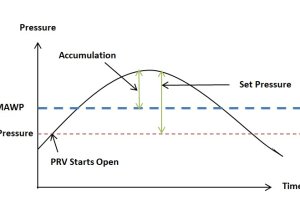Distillation is a commonly known method for separation of two liquid components with different boiling points. The ease of separation through distillation usually depends on the difference between boiling points. For a significant difference between boiling points of two liquids, they can be separated by batch distillation where one liquid remains almost completely in liquid form at the boiling point of the other liquid.
If the boiling points of two liquids to be separated are close to each other, the heavier liquid partially vaporizes at boiling point of the lighter liquid. Hence degree of separation is compromised in batch distillation. For such mixtures in vapor-liquid equilibrium conditions, both the phases - liquid and vapor - contain significant amounts of either component. But the compositions of both - liquid phase and vapor phase - depend on the temperature and pressure conditions. By manipulating the temperature and pressure conditions it is possible to achieve good degree of separation.
Continuous distillation column uses variation of temperature and pressure conditions along the height of the column to get more volatile component at the top of the column and less volatile component at the bottom of the column. The mixture to be separated is introduced at somewhere along the height of a vertical column. If the mixture contains more of lighter component, then the inlet is closer to top of the column. Conversely if the mixture has more of the heavy component, then inlet is closer to bottom of distillation column.
The column is provided with heat by a reboiler which is continuously boiling the liquid from the bottom of the columns. And the vapors from the top of the column are continuously cooled and condensed by an overhead condenser provided at the top of the column. The heating and cooling actions of these heat exchangers are responsible for vapor liquid equilibrium conditions in the column. Also due the action of reboiler the bottom of a distillation column has highest temperature and pressure conditions. The condenser is responsible for lowest temperature and pressure conditions at the top of the column.
A distillation column consists of a number of stages. Each of these stages is formed by a perforated tray. Liquid from the top condenser flows down from tray to tray to the column bottom. Vapors flow from bottom to top through the perforations in each of these trays. Thus trays provide the interface for vapor liquid contact and depending on the residence time on each tray the vapors and liquids tend to form vapor liquid equilibrium conditions. Hence each tray can be ideally thought of as vapor liquid equilibrium at different temperature and pressure conditions. The temperature and pressure decrease from tray to tray as we move from bottom to the top of the column, due to action of reboiler at bottom and condenser at top of column.
The vapor-liquid contact at each tray enhances separation. Heavy component vapors get condensed when they are in contact with cold liquid from the top. Conversely lighter component gets vaporized and stripped away from the liquid phase. Hence high number of separation implies higher degree of separation. A very high number of trays are often required to separate very closely boiling liquids or to get very high purity which is required for pharmaceutical substances.
All the above mentioned factors -reboiler, condenser, number of trays in a column - cause high concentrations of lighter component at top of the column and high concentration of heavy components at the bottom.





